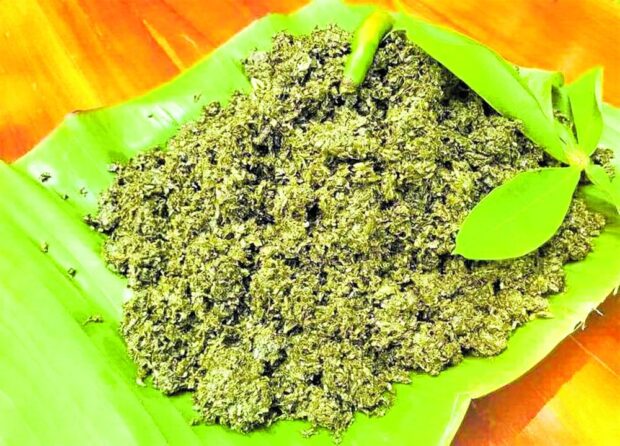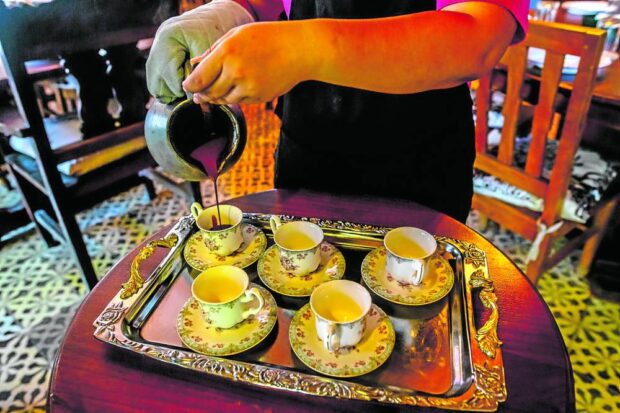Food is love language for Ilonggos

Ilonggos want other Filipinos and the global village to know its other offerings such as hot native chocolate with “tuba” and “linubak nga balinghoy.” —IAN PAUL CORDERO
ILOILO CITY—Iloilo has always been known for its cuisine—something that should not be surprising because food has always been an expression of love for the Ilonggos.
Guests, for instance, feel the Ilonggo warmth and hospitality by the abundance of food served whenever one visits.
But Iloilo’s cuisine is more than just “batchoy” (soup dish served with fresh noodles and innards) and “pancit molo” (soup dumplings) being offered in several restaurants in the city and province.
During the cultural mapping being conducted by the provincial government, for instance, at least 40 dishes have so far been documented, including heirloom dishes prepared using recipes handed down through generations.
“Our objective (for documenting the heritage dishes) is to preserve the traditional way of preparing the dish for the future generation and to honor the people who created these recipes,” said Gilbert Marin, provincial tourism officer.
According to Rafael Jardeleza Jr., in his book “Flavors of Iloilo,” Ilonggo cuisine is not complex but is actually simple and prepared in the traditional way “to preserve the freshness and delicate flavor of the ingredients abundant on the island.”
“The cuisine is considered the most delightful and the most diverse of cuisines in the Philippine archipelago,” he wrote.
Ian Mayer Varona, owner of 8 Villa Beach House in Iloilo City, said traditional Ilonggo cuisine could be characterized by its origin, ingredients and methodology.What makes Ilonggo cuisine unique is the use of local, indigenous ingredients as well as the cooking methods according to location.
Coastal, inland dishes
“We are blessed with good soil and rich marine resources,” said Marin.
In coastal areas, for example, the cooking method is “kilaw” or cooking fresh fish in vinegar.
Marin said the coastal towns of Tigbuan and San Joaquin, where fish is abundant, are known for their “kinilaw.” After catching the fish, these are washed in seawater, sliced and mixed with slices of tomatoes, ginger, onions and sea salt before cooking it in coconut vinegar, made from coconuts grown in the area.
The cooking method inland is also different.
One of these is what Ilonggos call “tinuom” or steaming ingredients while these are wrapped in banana leaves.
Slices of either native chicken, seafood, fish or mushrooms are wrapped tightly inside banana leaves together with tomatoes, ginger, onions and lemongrass stalks.
The banana packet is then placed inside a clay pot where it is cooked.
But according to Marin, some people just wrap the meat and aromatics in several layers of banana leaves before cooking them either in an open fire or over charcoal.
Tinuom is usually done early in the morning as the farmers take it with them as they leave the house to work in the fields to enjoy lunch.
Cabatuan town is known for its “tinuom na manok” (native chicken). In fact, several restaurants offering tinuom can be found along the road leading to the Iloilo International Airport in the town.
In Bingawan town, preparation of tinuom is slightly different. They sautè their aromatics and chicken before wrapping these in banana leaves.
Other towns also use tinuom as a cooking method but the “star” ingredients vary, depending on what is available in the locality and affordability.
In Calinog town, for instance, some families use river eel while others use different varieties of mushrooms.
Readily available
Marin said people in the municipalities use ingredients that are readily found in their backyard. Some of these ingredients may not be found in modern-day cooking.
Among these are cassava leaves that many believe to be poisonous.
But in Janiuay town, a staple dish is called “linubak nga balinghoy.” Cassava leaves are chopped finely and then squeezed to remove their bitter juice before these are cooked in coconut milk.
Passi City has its own version of linubak nga balinghoy but locals call it “binukbok nga balinghoy” because they also add in alumpiran leaves, one of those less known souring agents found in Iloilo.
Another heirloom dish is called “binayabsan,” a delicacy in Lambunao town that uses young leaves of guava (bayabas) which are crushed and cooked with onions, ginger, lemongrass and garlic.
According to the province’s cultural mapping data, binayabsan is an all-time favorite among Lambunaonons and is usually served during fiestas and special occasions.
Those who can afford prepare it with the choicest pork belly (binayabsan nga baboy) and sometimes are served on split bamboo poles (binayabsan nga baboy sa kawayan).
Lambunaonons also use young pumpkin leaves in making omelette for breakfast. They call this dish “tinipgang nga ugbos sang kalabasa.”
In the mountain municipality of Leon, locals have what they call “linagpang” where ingredients like meat, fish or chicken, and spices like onions and garlic, including tomatoes, are grilled before these are stewed. The result is a smoky soup with a lot of umami.
Asked why such a method is used, Marin has a simple explanation: “Mahal ang mantika (Cooking oil is expensive).”
Since linagpang is usually cooked near the farms, cooking oil is difficult to come by and can be expensive for rural folk. So, farmers use the next best thing to bring out the flavor of the ingredients: grilling.
‘KBL’
In Santa Barbara, residents use a different kind of souring agent that can rival the already popular “batuan” (Garcinia binucao): the fruits of a catmon tree. Some people describe the taste as a combination of green apple and “kamias” (Averrhoa bilimbi) but with a hint of sweetness.
Santa Barbara used to be called Catmon town due to the imposing catmon tree that served as a landmark of the municipality. It was later named after the patron saint of the town in 1760 when it was established as an independent parish. Now, the town has been planting several catmon trees to pay homage to its origin.
But the Ilonggo cuisine is now slowly evolving to keep up with the times. Some delicacies, for instance, have cheese varieties although the cooking methods remain the same.
According to Marin, Lambuano is now producing ube (purple yam) ice cream with “kadyos,” or pigeon peas that are the main ingredient in the famous KBL (kadyos, baboy and langka) and KBU (kadyos, baboy and ubad or the core of the banana stalk) in Iloilo.
In Cabatuan where cacao trees are abundant, families are now adding freshly harvested “tuba” (coconut wine) into their “tsokolate” (hot chocolate drink) instead of sugar.
Asked what it tastes like, Marin replied: “Mananit guid, promise. (I swear, it tastes really good).”
He pointed out that the newly harvested tuba is usually sweet and only turns sour when it starts to age.
Hotels have started putting local dishes on their menu. Even restaurants are paying tribute to local ingredients that define Iloilo cuisine.
Among these are the two restaurants that are owned and operated by Varona.
The Boathouse by 8 Villa along Iloilo River in Lapaz District, Iloilo City, seeks to globalize Ilonggo food by using local ingredients that are prepared using classical culinary techniques.8 Villa Beach House in Villa Arevalo District, Iloilo City, on the other hand, promotes sustainable and traditional Ilonggo coastal dishes since it is near the beach.
With efforts to promote Ilonggo cuisine—its ingredients and methodology—it is just a matter of time before Iloilo’s love language goes global.
After all, it is simple yet versatile but born out of love. INQ

